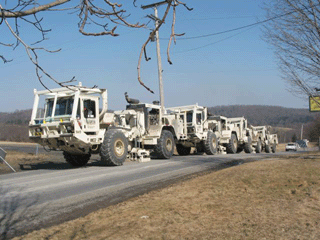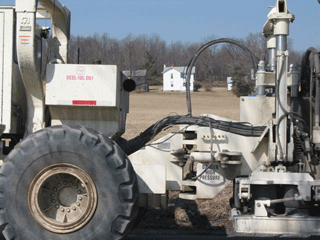Seismic waves
From Wikimarcellus
| Revision as of 21:25, 13 January 2009 Tcopley (Talk | contribs) ← Previous diff |
Current revision Tcopley (Talk | contribs) (cop081810) |
||
| Line 1: | Line 1: | ||
| - | '''Seismic waves''' are emitted by ''vibrator'' or ''thumper trucks''. These vehicles are specially equipped with an impact device, a large, metal, earth-vibrating foot, that generates ground waves. The trucks are driven down rural highways in areas where gas is suspected, and have electronic equipment on board to record the returns when sound waves bounce back from underground features. Usually, the survey area is carefully staked and marked with colored flags serving as measurement markers. Yellow and black cables run beneath the markers, connected to vibration sensor units spaced at intervals along the cables. Readings from the sensors help map out the boundaries of the underground rock formations. | + | '''Seismic waves''' are emitted by ''vibroseis trucks'' (aka vibrator or thumper trucks). These vehicles are specially equipped with an impact device, a large, metal, earth-vibrating foot, that generates ground waves. This process is sometimes referred to as ''geo-thumping''. |
| - | Reports often state that the noise and vibrations from thumper trucks can be heard for a considerable distance. The trucks work in groups of three or four, one right behind the other, and the impacts they generate are synchronized. | + | <center>http://www.sonic.net/~tcopley/img/thumper0.gif <br>'''Impact device'''<br>Courtesy of Peter Comly, [http://clodhopperfarm.blogspot.com/ - ''Clodhopper Farm'']</center> |
| - | The basic idea is to build a representational model of geological limits of the gas deposit. | + | |
| + | The trucks are driven down rural highways in areas where gas is suspected, and have electronic equipment on board to record the returns when sound waves bounce back from underground features. | ||
| + | |||
| + | <center>http://www.sonic.net/~tcopley/img/thumper1.gif <br>'''Convoy of four [[Dawson Geophysical Co|Dawson]] vibroseis trucks<br>sending seismic shock waves down through the road.'''<br>Courtesy of Peter Comly, ''Clodhopper Farm''</center> | ||
| + | |||
| + | Usually, the survey area is carefully staked and marked with colored flags serving as measurement markers. Yellow and black fiber optic cables run beneath the markers, connected to vibration sensor units spaced at intervals along the cables. Readings from the sensors help map out the boundaries of the underground rock formations. | ||
| + | |||
| + | Reports often state that the noise and vibrations from vibroseis trucks can be heard for a considerable distance. The trucks work in groups of three or four, one right behind the other, and the impacts they generate are synchronized. | ||
| + | |||
| + | A second way to generate seismic waves involves detonating small explosive charges in the ground. | ||
| + | |||
| + | The basic idea with either method of generating waves is to use the data collected to build a representational model of geological limits of the gas deposit. | ||
| Information from [[Seismic testing|seismic studies]] has occasionally been used for leverage in land negotiations between gas companies and landowners. | Information from [[Seismic testing|seismic studies]] has occasionally been used for leverage in land negotiations between gas companies and landowners. | ||
| + | |||
| + | |||
| + | [[Category:drilling practices]] | ||
Current revision
Seismic waves are emitted by vibroseis trucks (aka vibrator or thumper trucks). These vehicles are specially equipped with an impact device, a large, metal, earth-vibrating foot, that generates ground waves. This process is sometimes referred to as geo-thumping.
The trucks are driven down rural highways in areas where gas is suspected, and have electronic equipment on board to record the returns when sound waves bounce back from underground features.

Convoy of four Dawson vibroseis trucks
sending seismic shock waves down through the road.
Courtesy of Peter Comly, Clodhopper Farm
Usually, the survey area is carefully staked and marked with colored flags serving as measurement markers. Yellow and black fiber optic cables run beneath the markers, connected to vibration sensor units spaced at intervals along the cables. Readings from the sensors help map out the boundaries of the underground rock formations.
Reports often state that the noise and vibrations from vibroseis trucks can be heard for a considerable distance. The trucks work in groups of three or four, one right behind the other, and the impacts they generate are synchronized.
A second way to generate seismic waves involves detonating small explosive charges in the ground.
The basic idea with either method of generating waves is to use the data collected to build a representational model of geological limits of the gas deposit.
Information from seismic studies has occasionally been used for leverage in land negotiations between gas companies and landowners.


